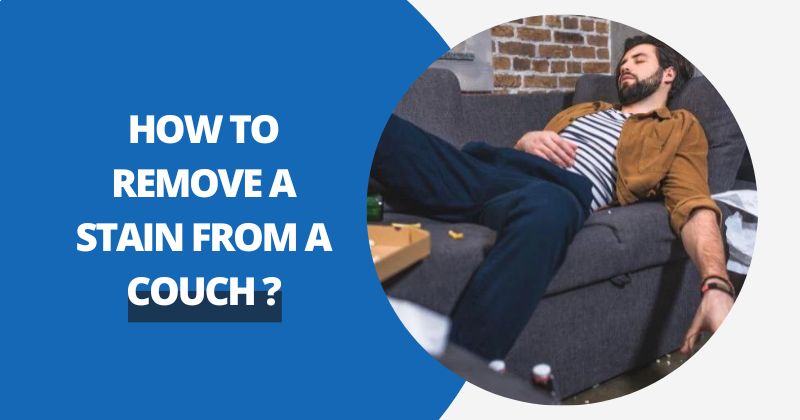Article: How To Get Stains Out Of Couch ?

How To Get Stains Out Of Couch ?
All you need to know to remove a stain from a couch
Being one of the most important pieces in your living room, the couch should always look new or at least stylish. For this, it's important to take care of it throughout its life. Yet, accidental spills may leave marks on your couch. You can opt for a couch cover or discover all our tips to help you get rid of them.
Ink stains
Makeup remover milk is the best solution to remove ink stains. Add a few drops of vinegar or 90° alcohol, then apply to the stained area and gently scrub with a sponge or cotton. Rinse with a damp cloth afterwards.
Grease stains
This requires swift action for best results. Use talc, flour, or Sommières earth to absorb the oil. Let it dry, then clean later. However, if the oil stain is older, you can remove it using ammonia soaked on a cloth. The amount varies depending on the stain's severity.
Blood stains
Use hydrogen peroxide or a mix of water and soda crystals to remove blood stains from your couch. Lighter stains can be removed with a mixture of water and talc or cornstarch. Hydrogen peroxide can also be used.
Water stains
As water doesn't leave a very dirty mark, you can easily remove its stain with a mixture of water and white vinegar. Gently scrub and let it act for a few minutes before rinsing with clear water.
Wine stains
If your couch is white, you can use hydrogen peroxide soaked on a cloth. Rinse with warm water. You can also use diluted ammonia depending on your couch's fabric. In this case, test with a cotton swab on a hidden area first.
Sauce stains
If it's a vinaigrette sauce, use talc or baking soda sprinkled on the stain. For greasy sauces, white vinegar will do. For mustard stains, use a mixture of hydrogen peroxide and ammonia or just lemon juice before rinsing.
Coffee stains
Rub the stain with almost dry Marseille soap, then let it dry and act for a few minutes. Then rinse with a cloth dampened with a mix of white vinegar and clear water. A mix of warm glycerin and hot water can also be used.
Fruit or vegetable stains
If your couch is white, scrub the stain with a cloth soaked in hydrogen peroxide or 70° alcohol, then rinse with warm water. Repeat the process until the stain disappears. For red fruit stains, use lemon juice and don't forget to rinse.
Makeup stains
Place absorbent paper on the stain, then pass a hot iron over it. Repeat the process several times, ensuring you change the paper whenever it gets dirty. However, makeup stains should never be wet.
Mold stains
Use a cloth soaked in a mix of ammonia and water. The dilution depends on the material of your couch cover. Always test on a hidden area first to prevent unwanted surprises.
Nail polish stains
Use an acetone-free nail polish remover. Apply with a cloth and rub gently without pressing too much. Rinse afterwards.
Urine stains
A mix of water, white vinegar, and baking soda is effective against urine stains. Let it act for a few minutes, scrub, and then rinse.
Candle wax stains
Place an absorbent paper or cloth over the wax and iron. This will make the wax melt and be absorbed by the cloth. You can also use a hair dryer. Once the wax is removed, clean the area with white vinegar.
Chewing gum stains
Put the stained area in the freezer or use an ice cube to freeze the gum. Once frozen, remove the gum and clean the area with white vinegar or 90° alcohol.
Paint stains
First, scratch the paint without damaging the fabric. Then, depending on the paint type, use either turpentine or white spirit. Always test on a hidden area first. For water-based paint, warm soapy water will suffice.
Mud stains
Let the mud dry first, then remove the crusts and vacuum. Apply soapy water to the stain, then rinse with clear water. If the stain persists, scrub with a mix of water and white vinegar.
Additional tips for stain removal
It is always advisable to treat stains as soon as possible. The longer they sit, the harder they become to remove. Always use clean cloths and avoid rubbing too hard to prevent damage. Finally, if you're unsure about the treatment or your couch's material, always do a patch test in a hidden area first.
For More information :
- How To Cover A Couch ?
- How To Clean A Couch ?
- How To Measure A Couch For A Cover ?
- How To Protect A Couch ?
- When Should You Change Your Couch Cover ?
- What's The Difference Between A Couch Protector And A Couch Cover?
- When Should You Change Your Couch Cover ?
- Couch Cover : How to Choose the Right Protection for Your Furniture?
- How to Keep Your Sofa Cover from Slipping

